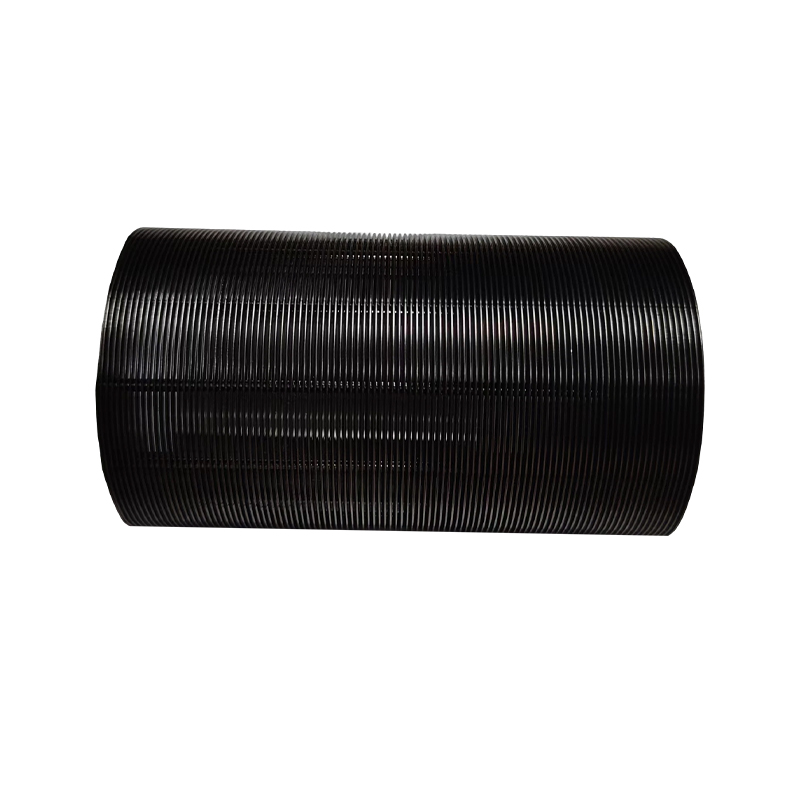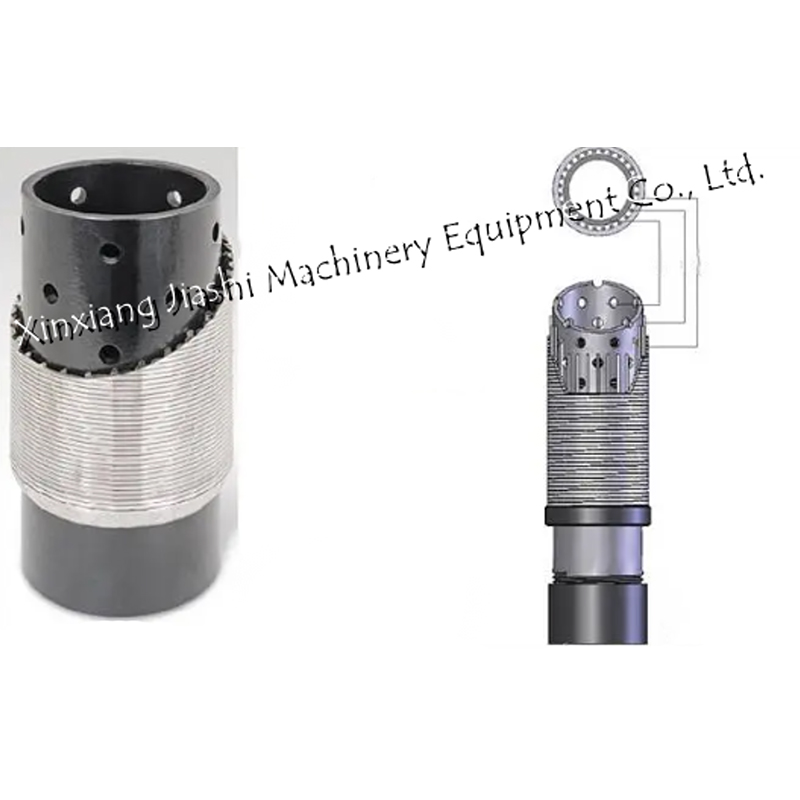How does the V-shaped structure of the curved screen avoid blockage and achieve efficient water flow?
Release Time : 2025-07-23
In modern industrial and water treatment systems, the performance of the screen as an important equipment for solid-liquid separation directly affects the filtration efficiency and the stability of the system operation. The curved screen has shown significant advantages in preventing blockage and improving the efficiency of water flow due to its unique V-shaped structural design. It is widely used in water treatment, mining, petroleum, food processing and other fields.
1. Basic structural characteristics of curved screen
The curved screen consists of a V-shaped cross-section contour line and a longitudinal support rod. Its core structure is a plurality of metal wire strips arranged in a V shape, and continuous gaps are formed between these wire strips. Unlike traditional round or square hole screens, the gaps of the curved screen are not closed holes, but a "V"-shaped channel formed by the intersection of two inclined planes. This design not only increases the effective opening area of the screen, but also makes the water flow less resistant when passing through, thereby improving the overall flow capacity.
2. How does the V-shaped structure avoid clogging?
In traditional screens, particles are easily stuck in round or square holes, causing the screen to be blocked, affecting the filtration efficiency, and even causing the system to shut down for cleaning. The V-shaped structure of the curved screen effectively avoids this problem from the design point of view.
Self-cleaning effect: The entrance of the V-shaped gap is larger and the exit is smaller. This "wide outside and narrow inside" design makes it difficult for particles in the water flow to get stuck when entering the screen. Instead, it is easier to be carried out or pass smoothly by the water flow, thereby reducing the possibility of clogging.
No dead angle at the intersection: At each intersection of the screen, the V-shaped structure remains open, without forming dead angles or grooves, avoiding the accumulation of impurities in these areas, further reducing the risk of clogging.
Structural continuity: The gaps of the curved screen are continuous strips, not discrete holes, which means that even if particles gather in some areas, the water flow can still pass through other areas to ensure the continuous operation of the system.
3. Reduce water flow speed and improve filtration efficiency
Another notable feature of the curved screen is the low flow rate passing characteristics brought by its continuous gap structure. Compared with traditional screens, curved screens have a larger effective opening area, which makes the water flow slower when passing through the screen, thus bringing the following advantages:
Reduce scouring and wear: Lower flow rate reduces the impact of water flow on the screen surface, reduces the wear rate of the screen, and prolongs the service life.
Improve filtration accuracy: Low flow rate helps particles stay on the screen surface for a longer time, improves the interception efficiency of the screen for fine particles, and thus achieves finer filtration.
Adapt to high sand content environment: In water sources with high sand content, low flow rate design can prevent sand and gravel from being embedded in the screen due to high-speed impact, reducing the risk of screen blockage and damage.
4. Good mechanical properties and pressure resistance
In addition to its advantages in anti-blocking and water flow control, curved screen also has good mechanical properties, especially in high pressure and high wear environment.
Longitudinal support rods enhance structural strength: Longitudinal support rods not only play the role of fixing the screen structure, but also effectively resist water flow pressure and external mechanical stress, preventing the screen from deformation or breakage during use.
Strong pressure resistance: Due to the geometric stability of the V-shaped structure itself, the screen can still maintain good structural integrity when subjected to high-pressure water flow or solid particle impact, and will not easily break or fail.
Suitable for high-pressure working conditions: In high-pressure environments such as oil drilling and mine dehydration, the curved screen can operate stably, effectively filter impurities such as sand and gravel, and ensure the safe operation of subsequent equipment.
The curved screen has excellent comprehensive advantages in anti-blocking, reducing water flow speed, improving filtration efficiency and enhancing mechanical properties through its unique V-shaped structural design. This structure not only improves the practicality of the screen, but also greatly extends its service life and reduces maintenance costs.
1. Basic structural characteristics of curved screen
The curved screen consists of a V-shaped cross-section contour line and a longitudinal support rod. Its core structure is a plurality of metal wire strips arranged in a V shape, and continuous gaps are formed between these wire strips. Unlike traditional round or square hole screens, the gaps of the curved screen are not closed holes, but a "V"-shaped channel formed by the intersection of two inclined planes. This design not only increases the effective opening area of the screen, but also makes the water flow less resistant when passing through, thereby improving the overall flow capacity.
2. How does the V-shaped structure avoid clogging?
In traditional screens, particles are easily stuck in round or square holes, causing the screen to be blocked, affecting the filtration efficiency, and even causing the system to shut down for cleaning. The V-shaped structure of the curved screen effectively avoids this problem from the design point of view.
Self-cleaning effect: The entrance of the V-shaped gap is larger and the exit is smaller. This "wide outside and narrow inside" design makes it difficult for particles in the water flow to get stuck when entering the screen. Instead, it is easier to be carried out or pass smoothly by the water flow, thereby reducing the possibility of clogging.
No dead angle at the intersection: At each intersection of the screen, the V-shaped structure remains open, without forming dead angles or grooves, avoiding the accumulation of impurities in these areas, further reducing the risk of clogging.
Structural continuity: The gaps of the curved screen are continuous strips, not discrete holes, which means that even if particles gather in some areas, the water flow can still pass through other areas to ensure the continuous operation of the system.
3. Reduce water flow speed and improve filtration efficiency
Another notable feature of the curved screen is the low flow rate passing characteristics brought by its continuous gap structure. Compared with traditional screens, curved screens have a larger effective opening area, which makes the water flow slower when passing through the screen, thus bringing the following advantages:
Reduce scouring and wear: Lower flow rate reduces the impact of water flow on the screen surface, reduces the wear rate of the screen, and prolongs the service life.
Improve filtration accuracy: Low flow rate helps particles stay on the screen surface for a longer time, improves the interception efficiency of the screen for fine particles, and thus achieves finer filtration.
Adapt to high sand content environment: In water sources with high sand content, low flow rate design can prevent sand and gravel from being embedded in the screen due to high-speed impact, reducing the risk of screen blockage and damage.
4. Good mechanical properties and pressure resistance
In addition to its advantages in anti-blocking and water flow control, curved screen also has good mechanical properties, especially in high pressure and high wear environment.
Longitudinal support rods enhance structural strength: Longitudinal support rods not only play the role of fixing the screen structure, but also effectively resist water flow pressure and external mechanical stress, preventing the screen from deformation or breakage during use.
Strong pressure resistance: Due to the geometric stability of the V-shaped structure itself, the screen can still maintain good structural integrity when subjected to high-pressure water flow or solid particle impact, and will not easily break or fail.
Suitable for high-pressure working conditions: In high-pressure environments such as oil drilling and mine dehydration, the curved screen can operate stably, effectively filter impurities such as sand and gravel, and ensure the safe operation of subsequent equipment.
The curved screen has excellent comprehensive advantages in anti-blocking, reducing water flow speed, improving filtration efficiency and enhancing mechanical properties through its unique V-shaped structural design. This structure not only improves the practicality of the screen, but also greatly extends its service life and reduces maintenance costs.







